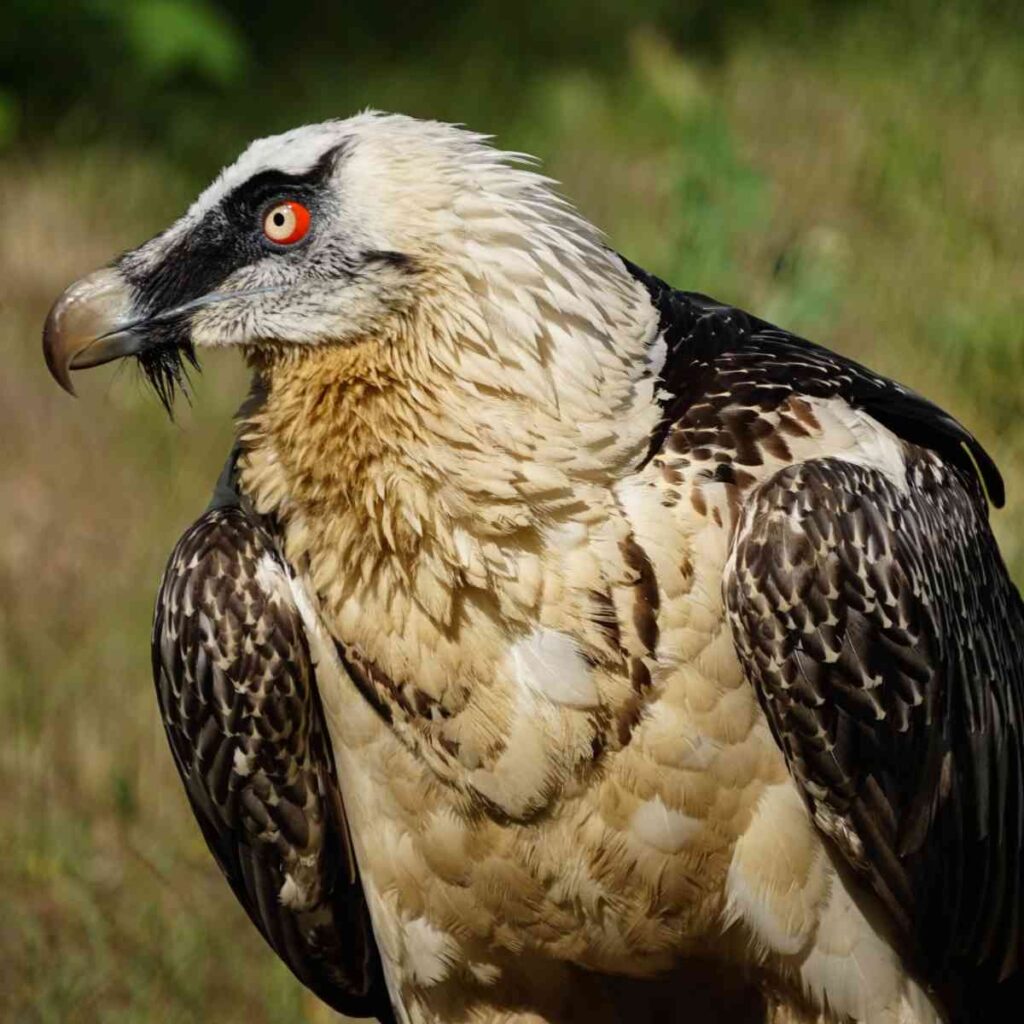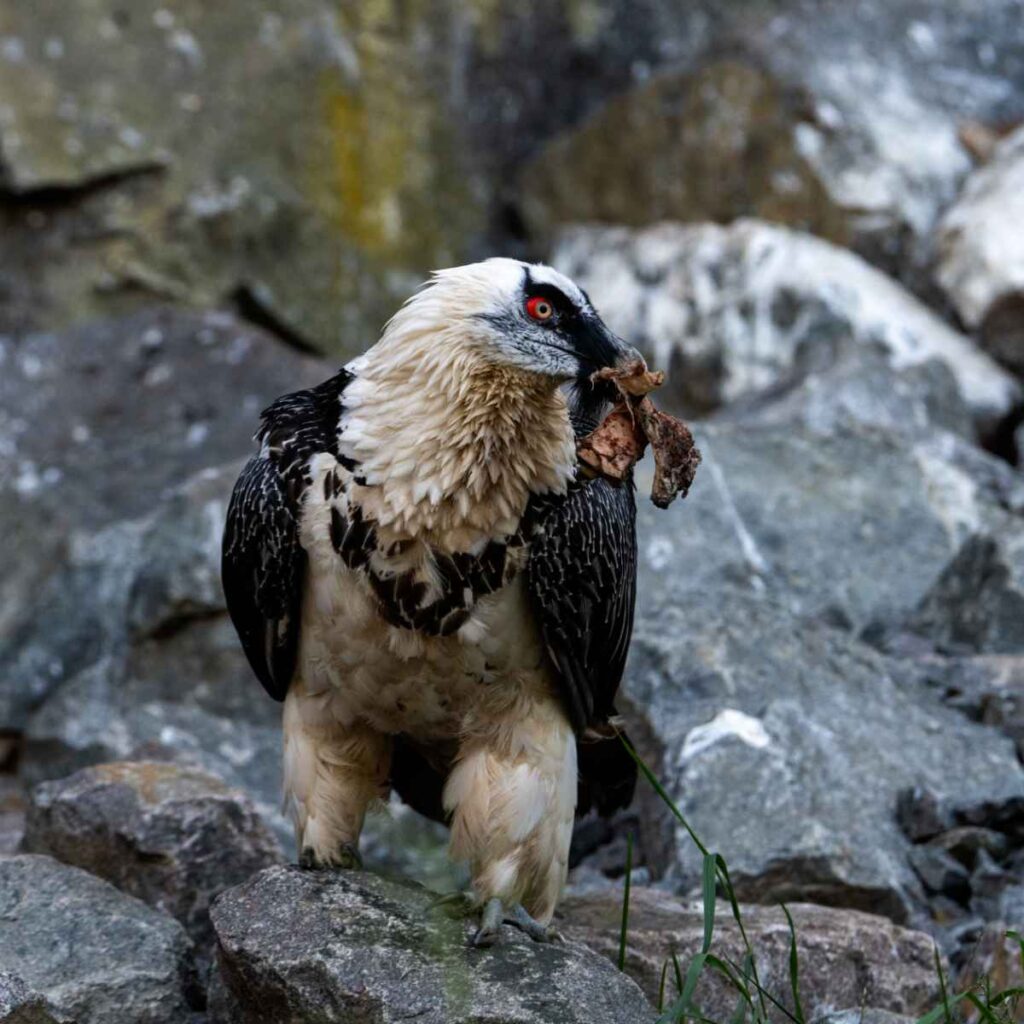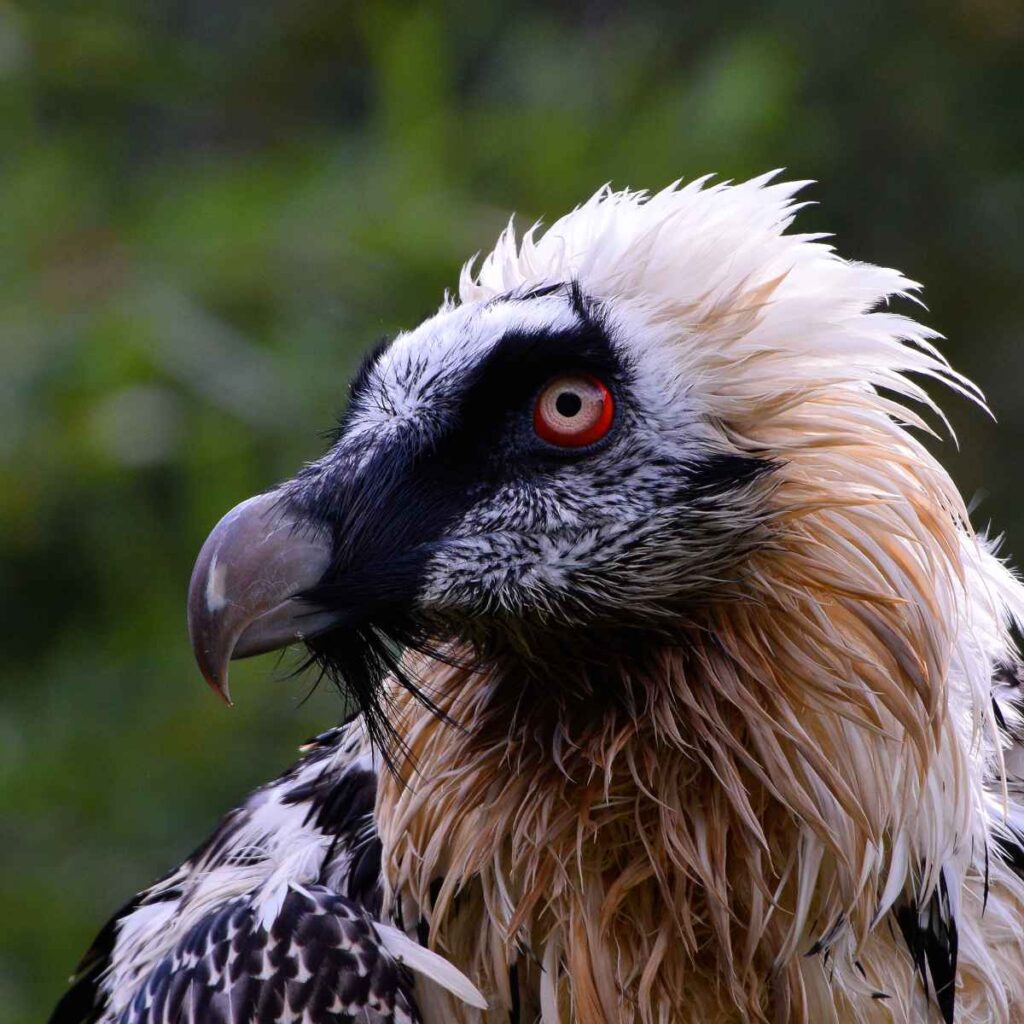Last Reviewed and Updated on January 31, 2023
The bearded vulture, also known as the lammergeyer, is one of the largest and most unique birds of prey. Learn more about this species, from the basic information all the way through to some of the most interesting facts about bearded vultures that set this one apart from other scavenging birds of prey.

About Bearded Vultures
Bearded vultures (Gypaetus barbatus), commonly also known as the lammergeier (originating from german, meaning lamb vulture) and ossifrages (from Latin, meaning sea eagle), are large birds of prey that are found in mountain ranges throughout Europe, Asia, and Africa.
On average, the adult bird is about 37–49 in / 94–125 cm long and has a wingspan of about 7 ft 7 in – 9 ft 3 in / 2.31–2.83 m. On average, they weigh 13.7 lb / 6.21 kg.
Adults are mostly dark grey, rusty and whitish.
The conservation status of bearded vultures is “near threatened,” according to the International Union for Conservation of Nature. Historically, the species’ population has been threatened by habitat loss, persecution, and poisoning, but conservation efforts have successfully stabilized and increased their populations in some areas.
Facts About Bearded Vultures
Now let’s explore some unusual and fun facts about bearded vultures.

1. Their signature rust color is “cosmetic” (applied to feathers)
The color of their feathers is naturally white. The color may come from drinking mineral-rich waters, rubbing mud on their bodies, and dust and mud-bathing in soils rich with ochre (usually iron) deposits.
The “addiction” to taint their feathers is genetically anchored (source).
2. They have one of the strongest stomach acids in the whole animal kingdom
Vultures generally have the strongest stomach acids, with the average pH of their stomach acid being 1.1. The bearded vulture has a stomach acid with 1 pH. Human stomach acid has a pH in the range of 1.5 to 2.
3. Their diet consists of 70-90% bone
Their diet consists primarily of bone, and their very acidic stomach acid makes it possible for them to dissolve bone more efficiently than any other vertebrate (animals with backbones; all mammals, birds, reptiles, amphibians, and fish).
They are the only known vertebrate whose diet consists of such a high percentage of bones.
4. Bearded vultures are the only living bird species that specializes in feeding on bones
Meat and skin comprise a very small percentage of adult birds’ diets (chicks feed on meat more). They get all nutrients they need from the bones. As they can dissolve most of the bone, even a larger one, they can consume all of the bone marrow, which contains fat and energy.
Another plus of their bone diet is that skeletons left on the mountains dehydrate and are preserved for months. These vultures can easily return to old and dried skeletal remains and eat them.
5. Unlike most vultures, these vultures don’t have a bald head
Vultures are known for their bald heads; however, the head of the bearded vulture is covered with feathers. One of the reasons vultures generally have bald heads is because of their meat scavenging, where they often push their heads inside the carcass. Having no feathers prevents the feathers from being soiled while they feed. As bearded vultures primarily feed on bones and not meat, this is one of the adaptations this species does not need.
6. These vultures learned to crack bones by dropping them from heights
Not all bones are small enough for bearded vultures to eat, but all are equally tasty. To solve this problem, these vultures learned to crack large bones by dropping them from heights onto rocks (similarly to how crows learned to crack nuts on roads). This breaks up the bone into smaller pieces which vultures can then eat. If the bone isn’t sufficiently cracked, they may repeat the process.
This is a learned skill that takes young birds years to master.
7. Unlike other vultures, they feed their young by carrying food to the nest
Other vultures feed their young with regurgitation (parents eat food and regurgitate it to young chicks), while bearded vultures carry food (usually limbs of sheep and other small mammals) straight to the nest for the chicks to feed upon.
8. They are scavengers but also attack live prey
Bearded vultures mainly scavenge for their food, flying around looking for skeletal remains. They can, however, attack live prey, too, and seem to do so more often than other vulture species. They are especially fond of turtles.
9. They are generally solitary but form strong breeding pair bonds
Although these vultures are generally solitary, they pair up and form close breeding pairs. Biparental monogamous care is seen in this species; both males and females work on the nest and care for their young.
10. Breading pairs lock feet with each other in flight and fall through the sky
One of the coolest facts about bearded vultures is their mating rituals. Mating rituals of bearded vultures are fascinating, involving aerial dances. They regularly lock feet with each other in the air and fall some distance through the sky with each other.
11. Their names stem from the beard-like bristles on their beaks

It really looks like they are rocking a black beard on their beaks.
12. They are one of the largest birds of prey
Their weight of about 9.9 to 17.2 lbs / 4.5 to 7.8 kg and a wingspan of 7 ft 7 in to 9 ft 3 in / 2.31 to 2.83 m place them high on the list when it comes to birds of prey (and birds in general).
13. Bearded vultures have a kite-shaped tail which is unusual for birds of prey
Fan-shaped tails are more common when it comes to birds of prey.
14. They are a symbol of luck and happiness in Iranian culture
In Iranian mythology, these birds are considered to be the symbol of luck and happiness; it was believed that if the shadow of a bearded vulture fell on someone, they would rise to sovereignty.
It was also believed that anyone who shot the bird would die in forty days.
15. It is one of the most endangered birds in Europe
There are efforts to reintroduce the species in some of its original environments.
Love reading about unique animals? Do check out our article on 100 weird animal facts.
